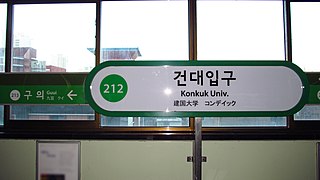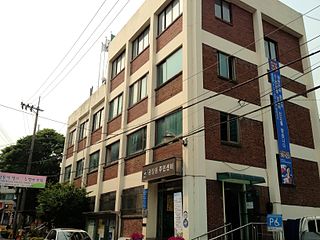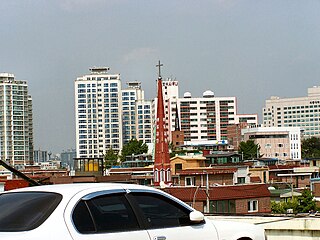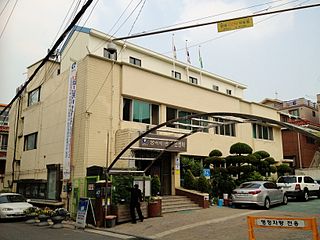
Gwangmyeong is a city in Gyeonggi Province, South Korea. It borders Seoul to the east, north and northeast, Anyang to the southeast, Siheung to the southwest, and Bucheon to the northeast.

Yeongdeungpo District is an administrative district in southwest Seoul, South Korea. Although the origin of the name is uncertain, the first two syllables are thought to be from "yeongdeung" (靈登) or "divine ascent", a shamanic rite. The third syllable is "po", representing the bank of a river (浦), referring to the district's position on the Han River. The 2006 population was 408,819.

Guro District (Guro-gu) is a district of Seoul, South Korea, which was separated from Yeongdeungpo District on April 1, 1980. Located in the southwestern part of the city, where besides Yangcheon District and Geumcheon District Guro District has an important position as a transport link which contains railroads, land routes from the rest of Seoul to the south of the country. The Gyeongbu and Gyeongin railway lines connect Seoul to Busan and Incheon. In addition, Seoul Metropolitan Subway lines 1, 2, and 7, and major highways intersect in Guro District.

Dongdaemun District is one of the 25 districts of Seoul, South Korea.

Geumcheon District (Geumcheon-gu) is one of the 25 gu (districts) of Seoul, South Korea. It was created from southern parts of Guro-gu and tiny sections from Gwangmyeong in 1995. Its district office is located in front of Siheung Station, now Geumcheon-gu Office Station, in Siheung-dong.

Gwangjin District is one of the 25 districts of Seoul, South Korea. It is located on the north bank of the Han River on the eastern end of Seoul. The district was split from the neighboring Seongdong District in 1995.

Konkuk University Station is a rapid transit station on Seoul Subway Line 2 and Seoul Subway Line 7. It is located in Hwayang-dong in the Gwangjin-gu administrative district of Seoul. It is adjacent to Konkuk University from which it takes its name. Line 2 is serviced by an elevated platform while Line 7 is serviced by an underground platform. The station has connections to ten bus lines through its six exits as well as a connection to the airport shuttle bus. The station services Hwayang-dong as well as Jayang-dong and Noyu-dong. The area around the station is mixed residential and small commercial businesses. Exits from the underground Line 7 platform open into Konkuk University and the adjacent Star City shopping and high-rise residential tower complex.

Guro-dong is a dong, neighbourhood of Guro-gu in Seoul, South Korea.
Sindorim-dong is a dong, neighbourhood of Guro-gu in Seoul, South Korea.
Oryu-dong is a dong, neighbourhood of Guro-gu in Seoul, South Korea.

Gwangjang-dong is a dong, neighbourhood of Gwangjin-gu in Seoul, South Korea.

Gunja-dong is a dong, neighbourhood of Gwangjin-gu in Seoul, South Korea. It is a transportation hub located on the southern side of Cheonho-daero, to the left of Jungnangcheon.

Hwayang-dong is a dong located in west Gwangjin-gu in Seoul, South Korea. It was incorporated into Gwangjin-gu on 13 August 1949. It is a mixed residential and small business area. Mojin-dong is also administered by Hwayang-dong and contains Konkuk University.
Jayang-dong is a dong, neighbourhood of Gwangjin-gu in Seoul, South Korea.

Junggok-dong is a dong, neighbourhood of Gwangjin-gu in Seoul, South Korea.
Neung-dong is a dong, neighbourhood of Gwangjin-gu in Seoul, South Korea.
Noyu-dong is a dong, neighbourhood of Gwangjin-gu in Seoul, South Korea. It is a legal dong administered under its two administrative dong, Jayang 3-dong and Jayang 4-dong.
Mojin-dong is a dong, neighbourhood of Gwangjin-gu in Seoul, South Korea.

Pyeongchang-dong is a dong, neighbourhood of Jongno-gu in Seoul, South Korea.

Seongsu-dong (Korean: 성수동) is a dong, or neighbourhood, of Seongdong District, Seoul, South Korea. It is further subdivided into Seongsu-dong 1-ga and Seongsu-dong 2-ga, and is served by Ttukseom Station and Seongsu Station on Seoul Subway Line 2 and by Seoul Forest Station on the Suin-Bundang Line. Its most notable attraction is Seoul Forest, a public park. The neighborhood has become popular in recent years for its array of cafes and restaurants, many of which have been set up in repurposed factories and old residential buildings, earning it the nickname "The Brooklyn of Seoul". There are also various stores built inside repurposed shipping containers.















